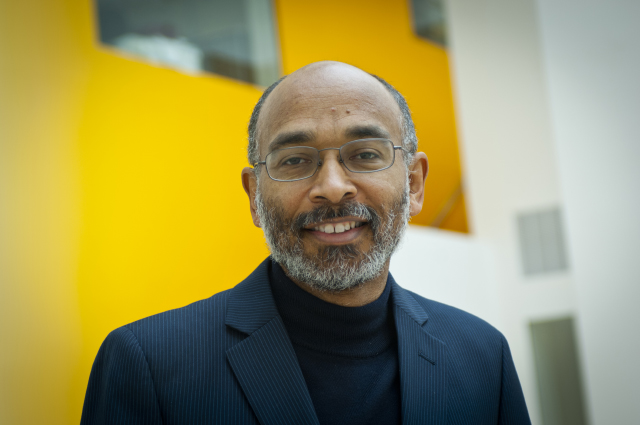When it comes to research, this accomplished statistician-anesthesiologist keeps an open mind
Emery Brown, A.B. ’78, entered Harvard as a pre-med student, planning to study romance languages and become a primary care physician working in international health. Today, Brown is an internationally acclaimed scientist whose research is deciphering how general anesthesia works in the human brain. He has been elected to all three branches of the National Academies (an accomplishment shared by only 18 other scientists). How did Brown go from a romance-language aficionado to world-renowned medical researcher?
Despite his love of languages (Brown speaks Spanish and French fluently), he felt drawn in a more scientific direction, and as a junior, switched his concentration to applied mathematics. After graduation, he studied mathematics during a year-long Rotary Fellowship at the Fourier Institute in Grenoble, France, before enrolling in the M.D./Ph.D. program at Harvard Medical School. Brown earned a Ph.D. in statistics, interned in internal medicine at the Brigham and Women’s Hospital, and then completed his anesthesiology residency at Massachusetts General Hospital (MGH).
He joined the anesthesiology faculty at MGH, where he continued research on mammalian circadian rhythms. Brown developed statistical methods to track internal time on the human biological clock, accurately calculate the clock’s intrinsic period, and precisely measure the ability of bright lights to shift the phase of the clock.

Emery Brown, A.B. '78 (applied math) is one of only 19 researchers to be elected to all three branches of the National Academies.
But after years of biological rhythms research, Brown, the Warren M. Zapol Professor of Anesthesia at MGH and Harvard Medical School, switched to a new research area: computational neuroscience.
His friend, (and fellow applied math concentrator) Steve Massaquoi, A.B. ’78, an MGH neurologist, persuaded Brown to consider brain research at a time when neuroscience was becoming a major National Institutes of Health (NIH) funding target.
“My Ph.D. research had been on statistical modeling of dynamical systems. What could be a better dynamical system to study than the human brain?” he said. “I was basically in hog heaven.”
In 2005, he joined the neuroscience faculty at the Massachusetts Institute of Technology, becoming one of only three people with joint professorial appointments at MIT and Harvard.
After successfully building signal-processing algorithms and statistical methods for neural data analysis, the physician-scientist began to ponder what would happen if he applied his newly found neuroscience insights to his day-to-day practice in anesthesiology.
“You could be a very good anesthesiologist and take great care of your patients just by following recipes,” Brown said. “At that time, not only didn’t we know how anesthesia worked, it was considered unknowable.”
To Brown, that sounded like a compelling challenge.
So he reached out to friends and colleagues and soon built a formidable, interdisciplinary research team to study how anesthetic drugs create the states of general anesthesia. His new research program received a boost after he was awarded the NIH Director’s Pioneer Award in 2007.
At the helm of this unique group, Brown was the first to show that anesthetic drugs do not “shut off” the brain. Rather, the drugs generate strong, highly structured oscillations that disrupt normal communication among brain regions. Despite anesthesiologists’ common practice of referring to anesthesia as sleep, it is actually a drug-induced reversible coma. His work has shown that different anesthetic drugs generate different oscillations based on the receptors and brain circuits they target. The structure of those oscillations changes systematically as the brain develops and ages.
Brown’s research has shown that by understanding the properties of these oscillations, anesthesiologists can more reliably monitor patients’ brains while they are under anesthesia. His research also helps anesthesia care givers dose the drugs more precisely.
“It is great that we have anesthesia, because it allows patients to humanely undergo surgery and traumatic diagnostic procedures, but it is also bad, in a sense, because these oscillations place the brain in states that are not natural. The effects of these states do not immediately disappear when the patient awakens,” Brown said.
This unnatural, drug-induced coma contributes to the periods of delirium and mental dysfunction patients often experience after anesthesia. For the elderly, this dysfunction can persist for days or even months.
Mitigating those negative after-effects by controlling anesthesia delivery is one focus of Brown’s current work. He and his team are building personalized control systems that will enable anesthesiologists to administer just the right amount of anesthesia a patient needs. As part of that effort, they are conducting a clinical trial on the use of intravenous Ritalin to rapidly awaken patients from anesthesia.
In addition, Brown and colleagues are developing new approaches to producing anesthesia. This work is especially compelling for Brown because it has broad implications, from developing new treatments for depression and insomnia to uncovering better ways to manage post-surgical pain. Even basic neuroscience could benefit—the ability to precisely control the brain’s anesthetic states provides a tremendous opportunity to better understand basic brain function.
“In the U.S. alone, 60,000 people receive anesthesia every day and there are huge ways to improve their care,” he said. “Understanding and controlling anesthesia is still a big question that we are working to answer, but I don’t see it as a huge mystery anymore.”
Watch Brown's TEDMED talk on what happens to the brain under anesthesia